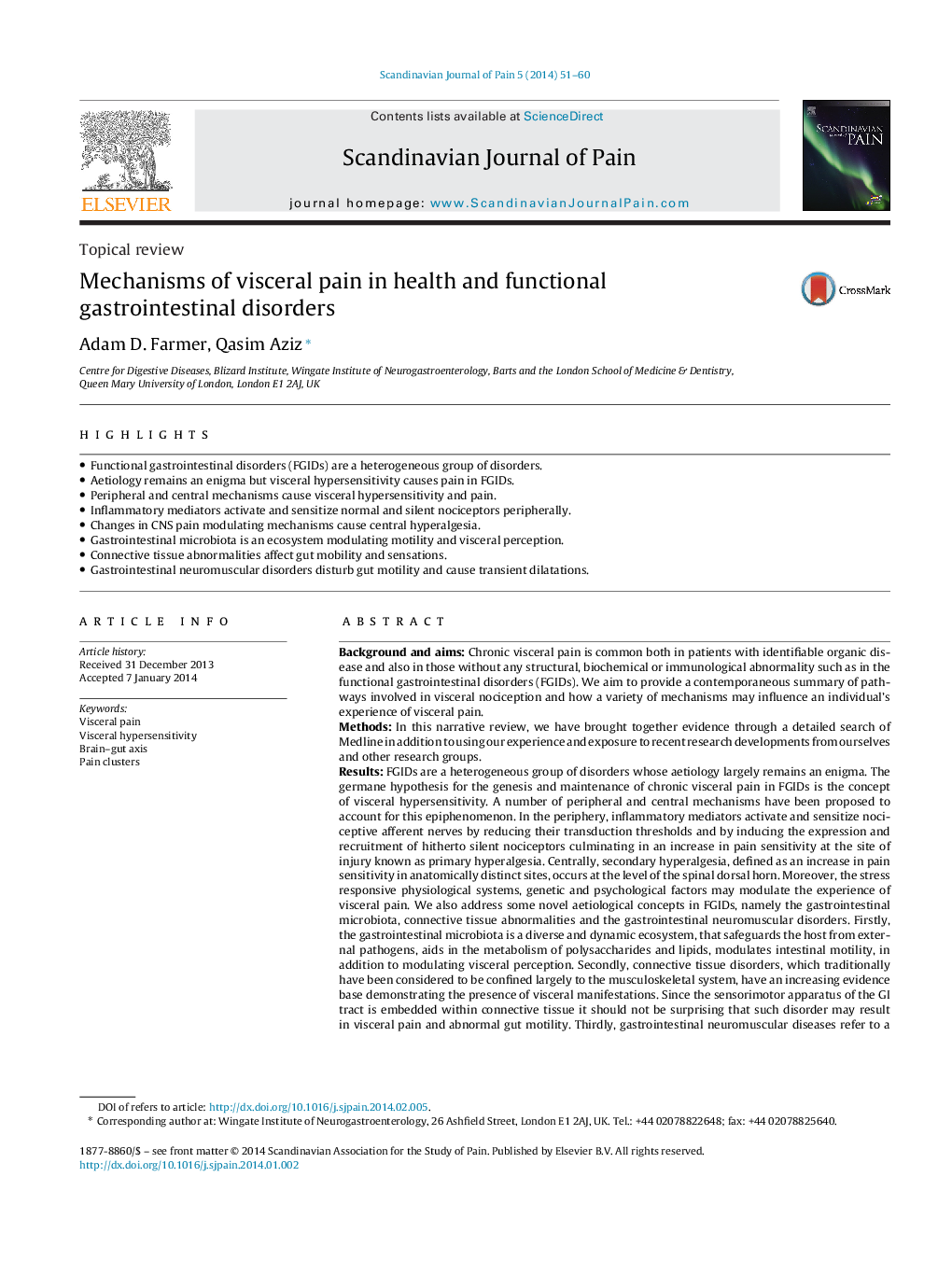| کد مقاله | کد نشریه | سال انتشار | مقاله انگلیسی | نسخه تمام متن |
|---|---|---|---|---|
| 2770755 | 1567817 | 2014 | 10 صفحه PDF | دانلود رایگان |
• Functional gastrointestinal disorders (FGIDs) are a heterogeneous group of disorders.
• Aetiology remains an enigma but visceral hypersensitivity causes pain in FGIDs.
• Peripheral and central mechanisms cause visceral hypersensitivity and pain.
• Inflammatory mediators activate and sensitize normal and silent nociceptors peripherally.
• Changes in CNS pain modulating mechanisms cause central hyperalgesia.
• Gastrointestinal microbiota is an ecosystem modulating motility and visceral perception.
• Connective tissue abnormalities affect gut mobility and sensations.
• Gastrointestinal neuromuscular disorders disturb gut motility and cause transient dilatations.
Background and aimsChronic visceral pain is common both in patients with identifiable organic disease and also in those without any structural, biochemical or immunological abnormality such as in the functional gastrointestinal disorders (FGIDs). We aim to provide a contemporaneous summary of pathways involved in visceral nociception and how a variety of mechanisms may influence an individual's experience of visceral pain.MethodsIn this narrative review, we have brought together evidence through a detailed search of Medline in addition to using our experience and exposure to recent research developments from ourselves and other research groups.ResultsFGIDs are a heterogeneous group of disorders whose aetiology largely remains an enigma. The germane hypothesis for the genesis and maintenance of chronic visceral pain in FGIDs is the concept of visceral hypersensitivity. A number of peripheral and central mechanisms have been proposed to account for this epiphenomenon. In the periphery, inflammatory mediators activate and sensitize nociceptive afferent nerves by reducing their transduction thresholds and by inducing the expression and recruitment of hitherto silent nociceptors culminating in an increase in pain sensitivity at the site of injury known as primary hyperalgesia. Centrally, secondary hyperalgesia, defined as an increase in pain sensitivity in anatomically distinct sites, occurs at the level of the spinal dorsal horn. Moreover, the stress responsive physiological systems, genetic and psychological factors may modulate the experience of visceral pain. We also address some novel aetiological concepts in FGIDs, namely the gastrointestinal microbiota, connective tissue abnormalities and the gastrointestinal neuromuscular disorders. Firstly, the gastrointestinal microbiota is a diverse and dynamic ecosystem, that safeguards the host from external pathogens, aids in the metabolism of polysaccharides and lipids, modulates intestinal motility, in addition to modulating visceral perception. Secondly, connective tissue disorders, which traditionally have been considered to be confined largely to the musculoskeletal system, have an increasing evidence base demonstrating the presence of visceral manifestations. Since the sensorimotor apparatus of the GI tract is embedded within connective tissue it should not be surprising that such disorder may result in visceral pain and abnormal gut motility. Thirdly, gastrointestinal neuromuscular diseases refer to a heterogeneous group of disorders in which symptoms arise from impaired GI motor activity often manifesting as abnormal transit with or without radiological evidence of transient or persistent dilation of the viscera. Although a number of these are readily recognizable, such as achalasia or Hirschsprung's disease, the cause in a number of patients is not. An international working group has recently addressed this “gap”, providing a comprehensive morphologically based diagnostic criteria.Conclusions/implicationsAlthough marked advances have been made in understanding the mechanisms that contribute to the development and maintenance of visceral pain, many interventions have failed to produce tangible improvement in patient outcomes. In the last part of this review we highlight an emerging approach that has allowed the definition and delineation of temporally stable visceral pain clusters, which may improve participant homogeneity in future studies, potentially facilitate stratification of treatment in FGID and lead to improvements in diagnostic criteria and outcomes.
Journal: Scandinavian Journal of Pain - Volume 5, Issue 2, April 2014, Pages 51–60
